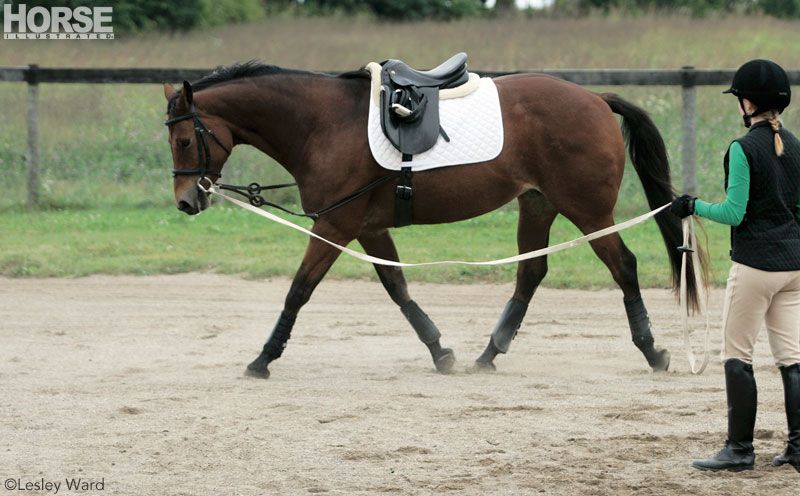Longeing Gear


You can’t expect to adequately control a horse, especially an energetic horse, if you are longeing in a loose halter. If you do longe in a halter, it must have a very close fit and not be able to twist sideways into the horse’s eye when there is tension on the longe line. You may find you have more control with a longeing cavesson which is designed for longeing and fits snugly. The longe line attaches to a ring on top of the noseband, so you don’t have to reattach the line when you change directions.
When longeing in a bridle, the longe line can be attached in two basic ways. You can pass the line through the inside bit ring (closest to the handler), over the horse’s poll, and then attach it to the bit ring on the opposite side. Or you can run the line through the inside bit ring, under the horse’s chin and attach it to the bit ring on the opposite side. Remove the reins, or secure them by placing them over the horse’s head and twisting both reins from bit to throatlatch; pass the throatlatch strap through the reins and fasten.
Many trainers like to use the Pessoa longeing rig, which operates on a pulley system and encourages the horse to use his hindquarters and is useful for setting the head. Another option is to use side reins, with a surcingle or a saddle, which can help the horse learn to carry himself in a balanced manner. If you’re not sure how to adjust, have an experienced horseperson help you.
Trainer, coach and competitor Lynn Palm recommends using a flat cotton longe line, never nylon, which is slippery, twists easily and can burn your hands. “You often see people with the longe line tangled in loops around their hands,” she says. “You should have the line ‘stacked’ in your hand in large loops so it doesn’t get tangled.” It’s also a good idea to wear gloves.
Use protective leg gear, such as splint boots or polo wraps, to protect the horse from injury due to over-reaching or brushing.
The longe whip acts as an extension of your arm, keeping the horse out on the circle and encouraging him to move on. “Practice using the whip and keeping your longe line organized before you get out there with the horse,” Lynn encourages.
Read on for tips on safe longeing >>
Recent Posts
2025 FEI Basel World Cup Finals Hands Reins to Fort Worth 2026
As U.S. athletes look back on valuable experience gained at the 2025 FEI World Cup Finals in Switzerland, the next…
How to Clean a Horse’s Sheath
If you’ve never cleaned a horse’s sheath, you probably have questions. First and foremost, is it really necessary? And more…
All Three Equestrian Sports Receive Final Confirmation for the LA 2028 Olympic Games
After a nail-biting two years of speculation about the inclusion of equestrian sports in the next Olympic Games, it was…
ASPCA Right Horse Adoptable Horse of the Week: Xanthus
Welcome to Horse Illustrated’s weekly installment of the Right Horse Adoptable Horse of the Week, offered in partnership with the…
Be Your Horse’s Joint Health Champion
Equine arthritis can affect horses of all disciplines and ages, and early intervention is crucial for maintaining comfort and performance.…
Tamie Smith: Taking It To The Next Level
Mother, grandmother, and winning 5* eventing rider—these three titles don’t typically go together. However, Tamie Smith, 49, is all of…
View Comments
I found it kind of general. But good for newbies at it.
This article was very helpful to me. I never knew some of the things it taught me. I think it was well written.